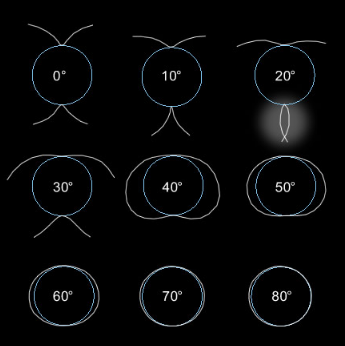Perfect Lower Tangent Arc - OPOD
Perfect Lower Tangent Arc - Exploring a Rare Atmospheric Phenomenon
Atmospheric optics never ceases to amaze us with its breathtaking displays. One such phenomenon is the Perfect Lower Tangent Arc, a rare and elusive sight that is often overshadowed by its more commonly observed counterpart, the upper tangent arc. In this article, we will delve into the intricacies of this optical wonder and uncover the science behind its formation.
A Glimpse of Perfection
Captured by the talented photographer Dario Labella in Italy, the images showcase the sheer beauty of the Perfect Lower Tangent Arc. While the upper tangent arc is frequently witnessed, the lower tangent arc is a much rarer spectacle. What sets these images apart is the extraordinary completeness and perfection of the lower tangent arc, a sight that is seldom encountered.
The Role of Hexagonal Column Crystals
The lower and upper tangent arcs owe their existence to hexagonal column crystals suspended in the atmosphere. These crystals, formed by low-level diamond dust, exhibit a unique property. As they descend through the air currents, aerodynamic drag aligns them in such a way that their long axes become nearly horizontal. This orientation allows rays of light to enter and exit the crystals through side faces inclined at approximately 60 degrees to each other.
Ever-Changing Shapes
The shape of the tangent arcs undergoes dramatic transformations with the changing altitude of the sun. When the sun is at an elevation of 29 degrees, the lower and upper tangent arcs merge to form what is known as the circumscribed halo. However, what distinguishes Dario's images is the absence of the common 22-degree circular halo, making the perfect lower tangent arc even more prominent and captivating.
The Flexibility of Column Crystals
A closer look at a singly oriented column crystal reveals its remarkable ability to rotate around its horizontal long axis. This rotation allows the crystal to assume various positions, enhancing the diversity of optical phenomena it can produce. The intricate interplay between the orientation and rotation of these crystals contributes to the mesmerizing patterns we observe in the atmosphere.
Unveiling the Wonders of Atmospheric Optics
The Perfect Lower Tangent Arc exemplifies the enchanting nature of atmospheric optics and the intricate mechanisms at play. By unraveling the science behind this phenomenon, we gain a deeper appreciation for the complexity of our atmosphere and its ability to create stunning displays of light.
To summarize the key points:
- The Perfect Lower Tangent Arc is a rare and rarely observed atmospheric phenomenon.
- Hexagonal column crystals, formed by low-level diamond dust, play a crucial role in its formation.
- Aerodynamic drag aligns these crystals horizontally, allowing light to enter and exit through inclined side faces.
- The shape of the tangent arcs changes with the sun's altitude, with a merging point at 29 degrees to form the circumscribed halo.
- The absence of the common 22-degree circular halo in Dario's images emphasizes the prominence of the perfect lower tangent arc.
- Column crystals possess the ability to rotate around their horizontal long axis, adding to the diversity of optical effects they can create.
In conclusion, the Perfect Lower Tangent Arc is a testament to the awe-inspiring beauty and complexity of atmospheric optics. Through the lens of talented photographers like Dario Labella, we are granted a glimpse into the remarkable phenomena that occur in our skies. Let us continue to marvel at these wonders and explore the mysteries that lie within our ever-changing atmosphere.

Perfect Lower Tangent Arc
Images from Italy by Dario Labella. Low level diamond dust crystals formed the halos.
An upper tangent arc on top of a 22-deg halo is a common sight. We see the lower tangent arc much less often and rarely as complete and perfect as this.
The bright spot at the bottom of the oval is a subsun.
Images ©Dario Labella, shown with permission

Hexagonal column crystals form the lower and upper tangent arcs. As they slowly drift downwards relative to air currents, aerodynamic drag orients them so that their long axes are almost exactly horizontal.
Rays enter and leave side faces inclined at 60 degrees to each other.
The tangent arcs change shape dramatically with the sun's altitude. They join when the sun reaches 29 degrees to form the circumscribed halo.
The blue circle represents the common 22 degree circular halo. It is absent in Dario's images.

A singly oriented column crystal. It can 'rotate' i.e. take all rotational positions about the horizontal long axis.
Note: this article has been automatically converted from the old site and may not appear as intended. You can find the original article here.
Reference Atmospheric Optics
If you use any of the definitions, information, or data presented on Atmospheric Optics, please copy the link or reference below to properly credit us as the reference source. Thank you!
-
<a href="https://atoptics.co.uk/blog/perfect-lower-tangent-arc-opod/">Perfect Lower Tangent Arc - OPOD</a>
-
"Perfect Lower Tangent Arc - OPOD". Atmospheric Optics. Accessed on November 25, 2024. https://atoptics.co.uk/blog/perfect-lower-tangent-arc-opod/.
-
"Perfect Lower Tangent Arc - OPOD". Atmospheric Optics, https://atoptics.co.uk/blog/perfect-lower-tangent-arc-opod/. Accessed 25 November, 2024
-
Perfect Lower Tangent Arc - OPOD. Atmospheric Optics. Retrieved from https://atoptics.co.uk/blog/perfect-lower-tangent-arc-opod/.